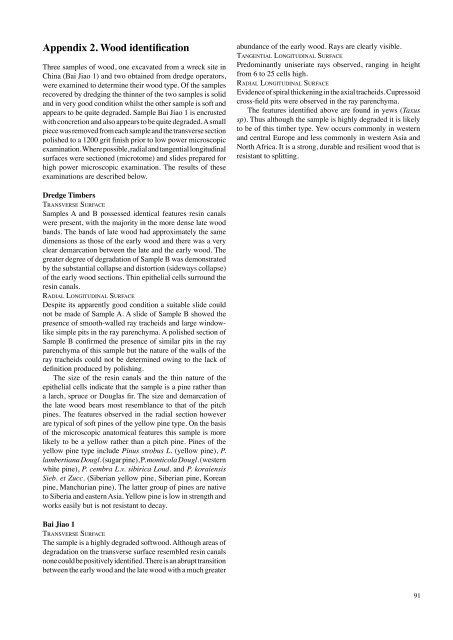No. 237 Maritime Archaeology in the People's Republic of China ...
No. 237 Maritime Archaeology in the People's Republic of China ...
No. 237 Maritime Archaeology in the People's Republic of China ...
Create successful ePaper yourself
Turn your PDF publications into a flip-book with our unique Google optimized e-Paper software.
Appendix 2. Wood identification<br />
Three samples <strong>of</strong> wood, one excavated from a wreck site <strong>in</strong><br />
Ch<strong>in</strong>a (Bai Jiao 1) and two obta<strong>in</strong>ed from dredge operators,<br />
were exam<strong>in</strong>ed to determ<strong>in</strong>e <strong>the</strong>ir wood type. Of <strong>the</strong> samples<br />
recovered by dredg<strong>in</strong>g <strong>the</strong> th<strong>in</strong>ner <strong>of</strong> <strong>the</strong> two samples is solid<br />
and <strong>in</strong> very good condition whilst <strong>the</strong> o<strong>the</strong>r sample is s<strong>of</strong>t and<br />
appears to be quite degraded. Sample Bai Jiao 1 is encrusted<br />
with concretion and also appears to be quite degraded. A small<br />
piece was removed from each sample and <strong>the</strong> transverse section<br />
polished to a 1200 grit f<strong>in</strong>ish prior to low power microscopic<br />
exam<strong>in</strong>ation. Where possible, radial and tangential longitud<strong>in</strong>al<br />
surfaces were sectioned (microtome) and slides prepared for<br />
high power microscopic exam<strong>in</strong>ation. The results <strong>of</strong> <strong>the</strong>se<br />
exam<strong>in</strong>ations are described below.<br />
Dredge Timbers<br />
tr a n S v e r S e Su r fa C e<br />
Samples A and B possessed identical features res<strong>in</strong> canals<br />
were present, with <strong>the</strong> majority <strong>in</strong> <strong>the</strong> more dense late wood<br />
bands. The bands <strong>of</strong> late wood had approximately <strong>the</strong> same<br />
dimensions as those <strong>of</strong> <strong>the</strong> early wood and <strong>the</strong>re was a very<br />
clear demarcation between <strong>the</strong> late and <strong>the</strong> early wood. The<br />
greater degree <strong>of</strong> degradation <strong>of</strong> Sample B was demonstrated<br />
by <strong>the</strong> substantial collapse and distortion (sideways collapse)<br />
<strong>of</strong> <strong>the</strong> early wood sections. Th<strong>in</strong> epi<strong>the</strong>lial cells surround <strong>the</strong><br />
res<strong>in</strong> canals.<br />
ra d i a l lo n G i t u d i n a l Su r fa C e<br />
Despite its apparently good condition a suitable slide could<br />
not be made <strong>of</strong> Sample A. A slide <strong>of</strong> Sample B showed <strong>the</strong><br />
presence <strong>of</strong> smooth-walled ray tracheids and large w<strong>in</strong>dowlike<br />
simple pits <strong>in</strong> <strong>the</strong> ray parenchyma. A polished section <strong>of</strong><br />
Sample B confirmed <strong>the</strong> presence <strong>of</strong> similar pits <strong>in</strong> <strong>the</strong> ray<br />
parenchyma <strong>of</strong> this sample but <strong>the</strong> nature <strong>of</strong> <strong>the</strong> walls <strong>of</strong> <strong>the</strong><br />
ray tracheids could not be determ<strong>in</strong>ed ow<strong>in</strong>g to <strong>the</strong> lack <strong>of</strong><br />
def<strong>in</strong>ition produced by polish<strong>in</strong>g.<br />
The size <strong>of</strong> <strong>the</strong> res<strong>in</strong> canals and <strong>the</strong> th<strong>in</strong> nature <strong>of</strong> <strong>the</strong><br />
epi<strong>the</strong>lial cells <strong>in</strong>dicate that <strong>the</strong> sample is a p<strong>in</strong>e ra<strong>the</strong>r than<br />
a larch, spruce or Douglas fir. The size and demarcation <strong>of</strong><br />
<strong>the</strong> late wood bears most resemblance to that <strong>of</strong> <strong>the</strong> pitch<br />
p<strong>in</strong>es. The features observed <strong>in</strong> <strong>the</strong> radial section however<br />
are typical <strong>of</strong> s<strong>of</strong>t p<strong>in</strong>es <strong>of</strong> <strong>the</strong> yellow p<strong>in</strong>e type. On <strong>the</strong> basis<br />
<strong>of</strong> <strong>the</strong> microscopic anatomical features this sample is more<br />
likely to be a yellow ra<strong>the</strong>r than a pitch p<strong>in</strong>e. P<strong>in</strong>es <strong>of</strong> <strong>the</strong><br />
yellow p<strong>in</strong>e type <strong>in</strong>clude P<strong>in</strong>us strobus L. (yellow p<strong>in</strong>e), P.<br />
lambertiana Dougl. (sugar p<strong>in</strong>e), P. monticola Dougl. (western<br />
white p<strong>in</strong>e), P. cembra L.v. sibirica Loud. and P. koraiensis<br />
Sieb. et Zucc. (Siberian yellow p<strong>in</strong>e, Siberian p<strong>in</strong>e, Korean<br />
p<strong>in</strong>e, Manchurian p<strong>in</strong>e). The latter group <strong>of</strong> p<strong>in</strong>es are native<br />
to Siberia and eastern Asia. Yellow p<strong>in</strong>e is low <strong>in</strong> strength and<br />
works easily but is not resistant to decay.<br />
Bai Jiao 1<br />
tr a n S v e r S e Su r fa C e<br />
The sample is a highly degraded s<strong>of</strong>twood. Although areas <strong>of</strong><br />
degradation on <strong>the</strong> transverse surface resembled res<strong>in</strong> canals<br />
none could be positively identified. There is an abrupt transition<br />
between <strong>the</strong> early wood and <strong>the</strong> late wood with a much greater<br />
abundance <strong>of</strong> <strong>the</strong> early wood. Rays are clearly visible.<br />
ta n G e n t i a l lo n G i t u d i n a l Su r fa C e<br />
Predom<strong>in</strong>antly uniseriate rays observed, rang<strong>in</strong>g <strong>in</strong> height<br />
from 6 to 25 cells high.<br />
ra d i a l lo n G i t u d i n a l Su r fa C e<br />
Evidence <strong>of</strong> spiral thicken<strong>in</strong>g <strong>in</strong> <strong>the</strong> axial tracheids. Cupressoid<br />
cross-field pits were observed <strong>in</strong> <strong>the</strong> ray parenchyma.<br />
The features identified above are found <strong>in</strong> yews (Taxus<br />
sp). Thus although <strong>the</strong> sample is highly degraded it is likely<br />
to be <strong>of</strong> this timber type. Yew occurs commonly <strong>in</strong> western<br />
and central Europe and less commonly <strong>in</strong> western Asia and<br />
<strong>No</strong>rth Africa. It is a strong, durable and resilient wood that is<br />
resistant to splitt<strong>in</strong>g.<br />
91

















